On the side of many concrete buildings throughout the world, massive weeds have been appearing, causing people to turn their heads and crane their necks in spite of the fact that most people see weeds as undesirable and worthy only of being eradicated. These happen to be work of Swiss-born Mona Caron and are part of an ongoing mural series called, "Weeds."
Since 1998, Caron has created murals (and posters) that support social movements, activism (she calls this work "artivism), and the remembering of forgotten segments of society. The "Weeds" series, though different in scale and technique from her earlier work, shares fundamental values and philosophical beliefs with these earlier works.
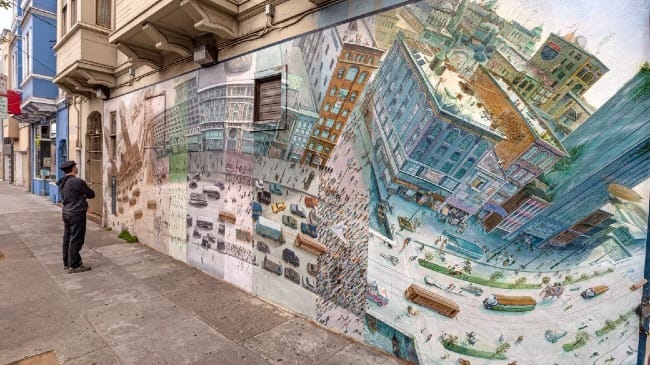
For many years, Caron created extremely labor-intensive, highly-detailed depictions of very specific places, often within her adopted hometown of San Francisco, California. Two of these murals: "Market Street Railway" and "Windows into the Tenderloin," minutely reflect the neighborhood in which they are located, even to the extent of including images of real community members within the murals. The Tenderloin area, in particular, is an area with serious difficulties, and the making of the mural was featured in an award-winning documentary.
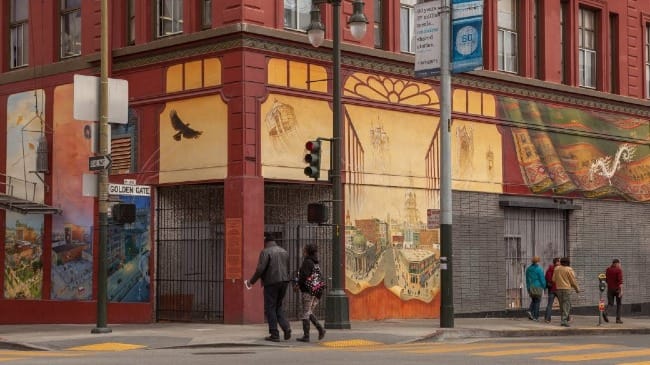
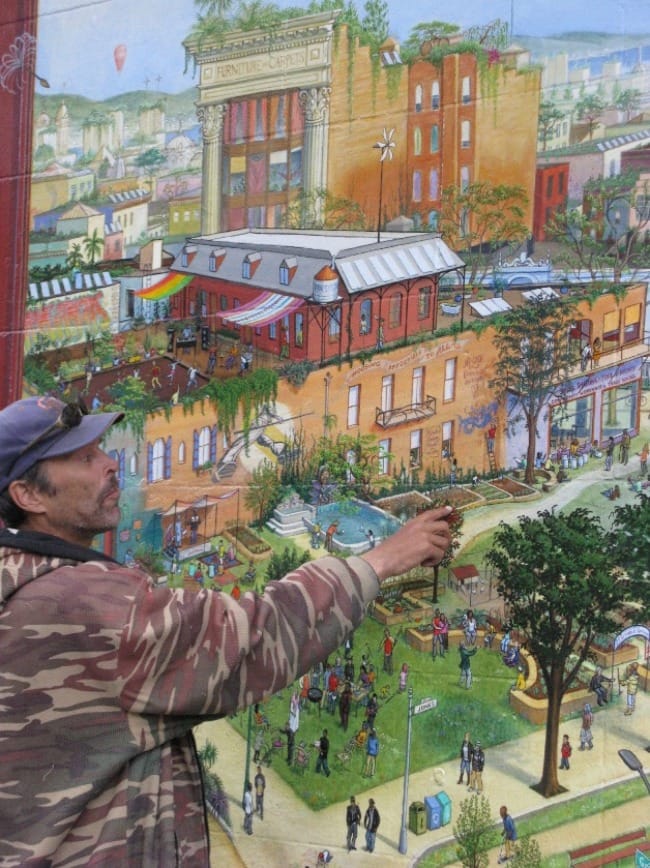
Left: Section of Windows into the Tenderloin. Right: Detail of "Another Way"" section of mural.
In "Windows into the Tenderloin," Caron included a panel called, "Another Way," which she created after interviewing many, many community members. It translates into mural form the articulated dreams of the people Caron talked to while planning and creating the mural, showing a possible future, different from what currently exists in this place. An uncared-for parking lot is transformed into a thriving community green space, populated with recognizable representations of the very people who shared their dreams with Caron about what this place could look like and be.
With her "Weeds" murals, Caron has shifted. Instead of time-intensive, extremely detailed depictions of an entire neighborhood shrunk down to the size of a wall or side of a building, she is now often expanding a single stalk of a plant into a large-scale mural that covers an entire large wall or even the side of a several-storied skyscraper.
The inspiration for the "Weeds" series originated from her time working on the "Windows into the Tenderloin" project. Over the course of the year she spent working on it, she noticed a single dandelion that kept popping up at the base of the wall where she was working. It would sprout up through the cracks, begin to grow, reach a certain height where it would be noticed and wiped out by someone who came along to "clean up" the area by getting rid of the weeds that "dirtied" up the sidewalk. Eventually, it would sprout up again, and would begin to grow upward, only to again be cleaned up by someone who saw it as unwanted and undesirable. Caron became inspired by the dandelion and its resilience. She started thinking about weeds, and how they are a picture and lesson for those people and things that keep coming back even when they are not wanted or welcomed.
As she says, It occurred to me, what that condition is — the radical patience of that dandelion asserting itself and reasserting life in that concrete in a place where nobody has given it permission to exist.
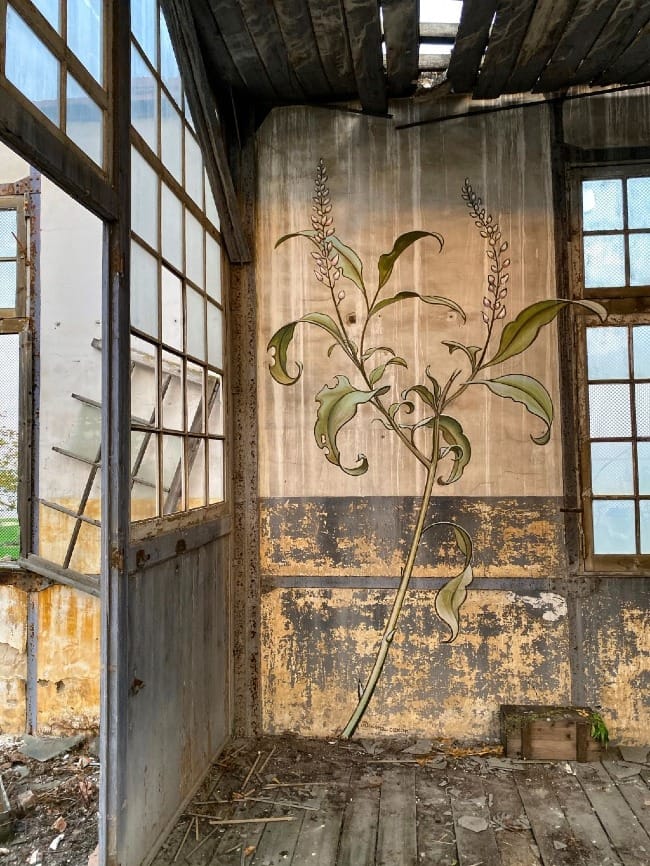
She began doing what she calls "phytograffiti," or "plant graffiti," leaving often small scale murals of weeds scattered throughout the city.
At the same time, she began a side, personal project—a series of stop-motion images that she turned into a video and added to her YouTube channel, which at the time had very few followers. The video resonated with people and suddenly her audience numbers exploded. She heard from people around the world saying how much the storyline resonated with them and how they identified with the narrative of the weed—struggling, growing, surviving in spite of being unwanted and unnurtured. (You will find the video at the end of this post).
Since then, Caron's weed murals have been in high demand around the world including Brazil, France, Sweden, Switzerland, Belgium, and various spots in the U.S. In July 2021, she created a huge mural on a 20-story building in Jersey City, New Jersey.
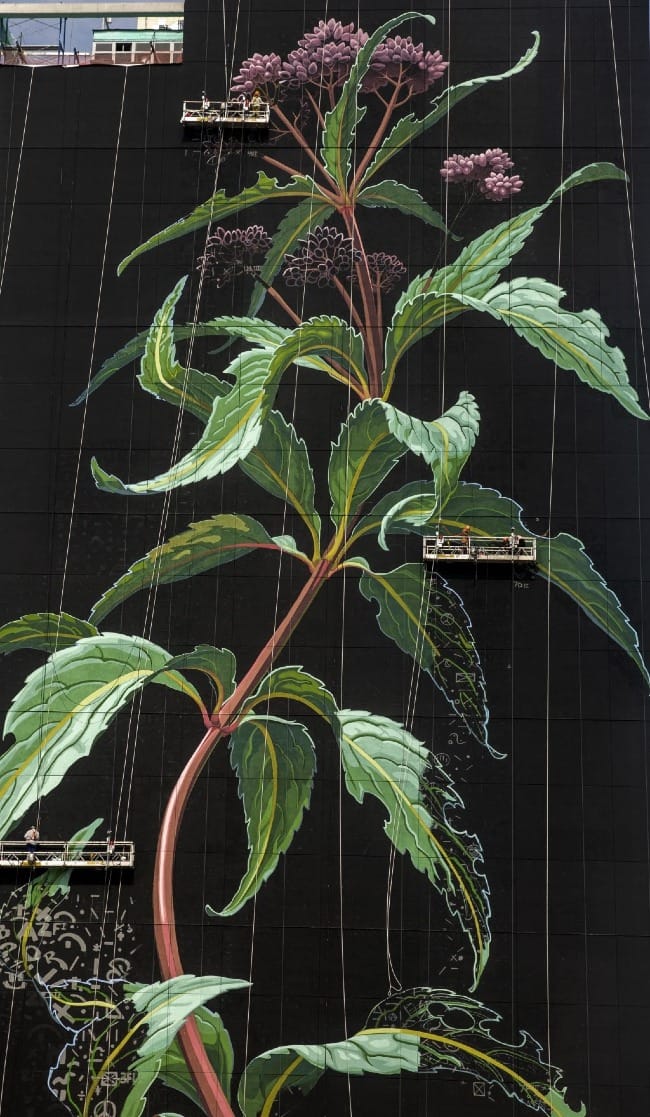
As is her practice, Caron chose for her model a flower that is significantly connected to the particular place. The Joe Pye weed, a purple wildflower that is native to coastal areas in the eastern U.S., including New Jersey, is the weed she chose for the mural. In the picture above you can see how the black background behind the flower emphasizes the details and color of the piece and you can also see a bit of the her painting method as the mural is a work-in-progress in the photo.
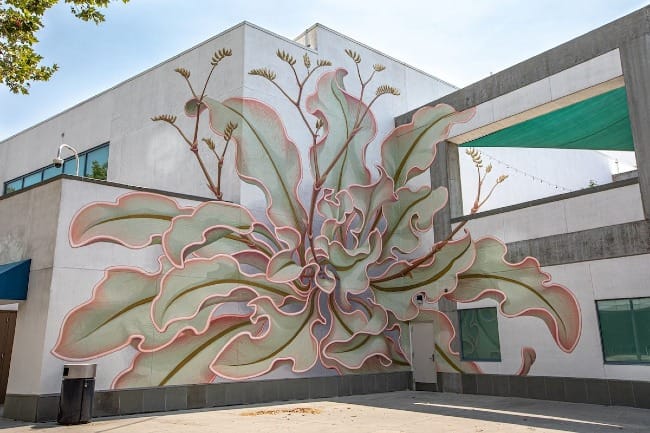
The Limonium plant (statice) she chose for the San Jose commission pictured above is a wild herb native to the salt marsh tidal lands of the San Francisco Bay. It is an indicator species of the Bay’s ecological health and thus especially significant to the area. The three-dimensional effect of the painting is particularly striking.
She describes her work in this way, "I look for clandestine plant life in the city streets. When I find a particularly heroic specimen growing through a fissure in the pavement, I paint it big, at a scale inversely proportional to the attention and regard it gets."
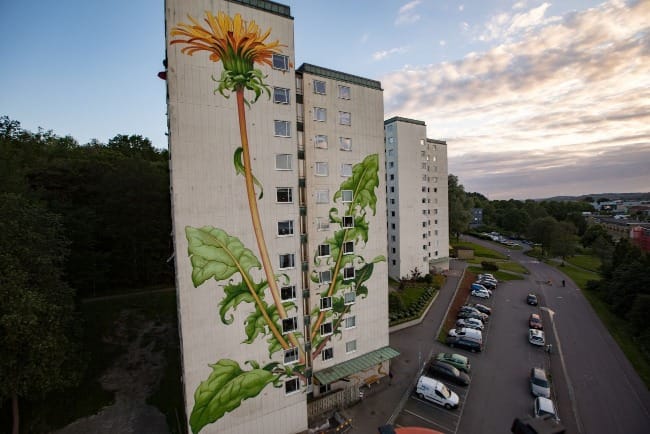
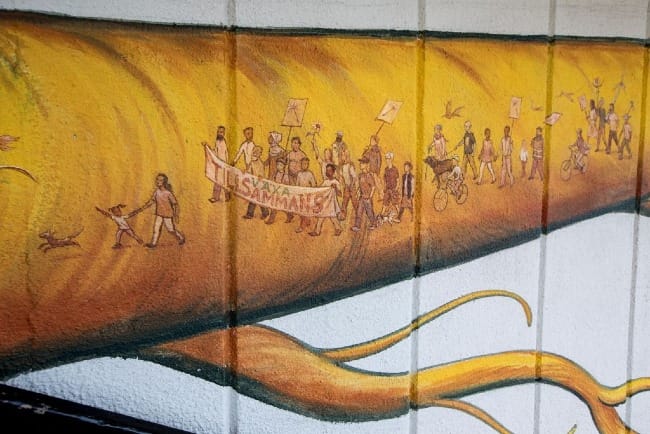
Left: Marskros (Dandelion)—Grow Together, Gothenburg, Sweden, Mona Caron. Right: Detail from Marskros—Grow Together
In Gothenburg, Sweden, Caron visually binds together two parts of an apartment complex with her dandelion mural, Marskros—Grow Together. In addition to the visual unity created by the upper part of the plant, the root system of the plant, painted beneath the awning entrance at the bottom right of the mural, incorporates members of the community into it, suggesting that this human community gives strength to the dandelion-like things that strive to grow and thrive around them.
Including the margins in her murals—indigenous women striving to protect their land from detrimental projects, local Bolivians fighting against water privatization—has long been central to Caron's work. With the "Weeds" series, this sense of margin includes the nonhuman parts of creation as well. By making the work less site-specific, it seems to have expanded the audience who are able access the meanings and grasp the images of hope, resilience and the possibility of change that the weeds represent.
As Caron says, I doubt that the type of change that we really need will ever come from the manicured lawns at the center of places where power is concentrated. The real change is coming from the margins, like we need to start paying attention to what’s growing on the margins of things, and discover a new beauty there.
Can you think of change that is trying to grow on the margins of where you live? Are there "weeds" that you need to nurture, or at the very least need to hold back from "cleaning" up, and thus destroying?
You can see more about Mona Caron's work here and her Weeds video may be viewed below.
Feel free to email me at info@circlewood.online or leave a comment below.
Louise
